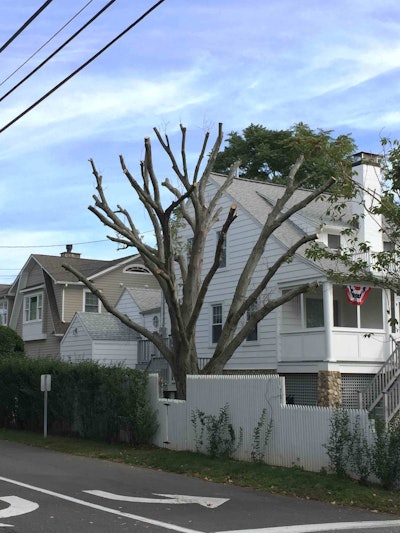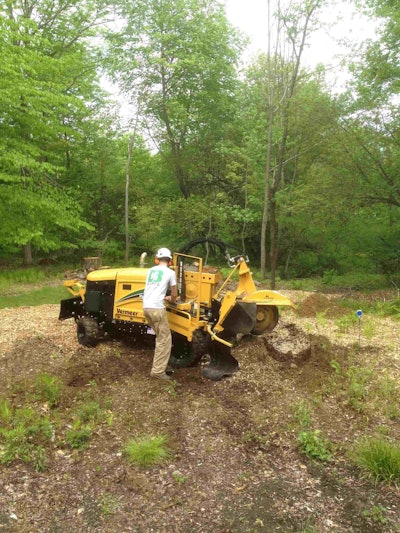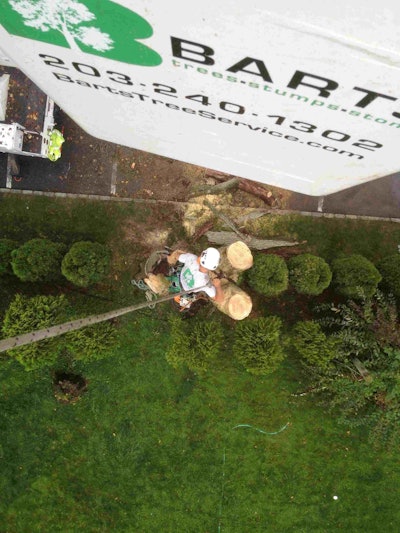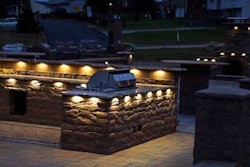 Improper pruning of the uppermost branches, called topping, results in unsightly and weak new growth that easily breaks off, becoming a hazard to people and property.
Improper pruning of the uppermost branches, called topping, results in unsightly and weak new growth that easily breaks off, becoming a hazard to people and property.Photo: Barts Tree Service
Trees are the living, breathing, crowning glory of any landscape, so they need a little TLC like any other plant.
“Part of our job is to educate clients about their trees,” says Matt Bartelme, certified arborist and president of Barts Tree Service in Danbury, Connecticut. “Many common tree care practices actually are not recommended for the health of the tree in the long run.”
Improper planting can shorten a tree’s lifespan by making it vulnerable to insects, disease and storm damage. Poor pruning techniques, such as the practice of “topping,” or shearing off the topmost branches, cause the tree to become a hazard.
“Leaves make food for trees. Stub cuts at the top of a tree cause the tree to grow new sprouts aggressively in an attempt to save itself,” says Bartelme. “That creates weak branches that tend to snap off eventually.”
Follow these tips to keep your clients’ trees healthy and to give every new tree a good start in life:
Dig the right-size hole
“The number one problem we see is that most new trees are planted too deep,” says Tchukki Andersen, certified master arborist and staff arborist with the Tree Care Industry Association. “A tree that’s too deep may survive a few years, but it won’t grow to its mature height and spread. It doesn’t add value to a property if you have to replace that same tree every decade, and you lose money if your plantings fail.”
Dig a hole that’s at least two to three times wider than the root ball and only as deep as the root ball. Watch for circling (girdling) roots, which are common in containers, and loosen and spread them out in the hole as much as possible.
Don’t get overly concerned about disturbing the roots; it’s not as important to keep that tight wad of soil in place as it is with herbaceous plants such as annuals, Andersen says.
Get rid of excess soil
 Professional arborists routinely use stump grinders in their cleanup operations.
Professional arborists routinely use stump grinders in their cleanup operations.Photo: Barts Tree Service
Many container or balled and burlapped (B&B) trees have excess soil on top of their root balls. Remove enough soil from the top of the root ball to expose the root flare, where the trunk tapers and widens at the base.
“All too often we see the flare of the tree planted well below grade,” says Ryan Burlingame, certified arborist with Wright Outdoor Solutions in West Des Moines, Iowa. “This causes health and stability issues in the future.”
Place the tree at grade or slightly above grade in the hole, then backfill. Make sure the tree’s root flare is visible after planting; the tree should never look like a telephone pole sticking out of the ground. Learn more planting and care tips here.
Remove burlap or wire cage completely
Burlap doesn’t decompose as quickly as you think; it can take years.
Remove it completely and cut natural or synthetic twine, too. Use small bolt cutters to cut away wire cages.
“The burlap or wire cage can inhibit root growth,” says Andersen. “You want the tree to be able to stretch its roots once it’s in the ground and not have to grow around obstacles.”
Mulch correctly
Keep mulch six to eight inches away from the base of the tree, not mounded up against the trunk so it looks like a volcano.
“Mulch against the trunk creates a false environment that’s too wet in an area that’s not meant to be wet,” says Bartelme. “That leaves the tree vulnerable to fungal and insect attacks.” If clients insist on uniform mulching for appearance’s sake, topdress the area with a very thin layer, tapering to nothing closest to the trunk.
Mulch not only conserves moisture, it also protects young trees from injury. “String trimmer and mower damage is the worst thing for young trees,” says Bartelme. “If a machine rips into the cambium layer below the bark, nutrients won’t pass beyond that spot to the rest of the tree.”
Don’t stake and forget
“Trees often get staked and forgotten about,” says Burlingame. “We’ve all seen trees with wire embedded in them. This girdles the tree, weakens it and becomes an entry point for disease and insects. If a tree is planted correctly, most of the time there is no reason to stake the tree longer than one year.”
Never, ever top trees
Just because you may have seen it done over and over through the years is no reason to follow suit: Never top trees.
“It mutilates the tree, weakens it, contributes to its decline and creates ugly, unstable top growth that becomes a hazard,” says Andersen. If you need to reduce the overall size of a tree, consult a certified arborist to perform selective pruning correctly.
Stay in the loop
As with any other aspect of your business, educate yourself about emerging tree health diseases and pests. Talk to local nurseries. Check local universities and cooperative extension offices for classes. Participate in tree stewardship seminars offered by many cities and botanic gardens across the country, says Burlingame. Do an Internet search for “tree stewardship programs” to find one in a city near you.
Build relationship with arborist
 Certified arborists are qualified to handle the most challenging tree removal tasks.
Certified arborists are qualified to handle the most challenging tree removal tasks.Photo: Barts Tree Service
Tree work is hazardous and sometimes deadly. Electrocutions, falls, and being struck by falling debris are the most common causes of fatalities among tree workers every year. When it’s time to evaluate tree health or perform dangerous tasks such as pruning, it’s best left to certified arborists.
It’s also a legal issue: “Tree professionals have a liability policy that accommodates for our type of work,” says Bartelme. “Landscape professionals may be covered at ground level for liability, but they are not covered for tree work. You could be one incident away from bankruptcy if you don’t know your insurance.”
If your clients need tree work, consider partnering with a local tree company. “You can add a small percentage to their estimate for your clients, refer work to each other and establish a network of professional offerings so that everyone benefits in the long run,” says Bartelme.









